How to Set up Parental Control on Windows 10 in 2025
Setting up parental controls on Windows 10 is a straightforward process. Log in to your Microsoft Safety account and open the settings menu. There, you can set screen time limits, a web filter, and get detailed activity reports on what your kids are doing on Windows 10.
That said, the Microsoft Family Safety app has its limitations. It only monitors content on the Edge browser, SafeSearch is limited to Bing, its filter lacks categories and isn’t customizable, and tech-savvy kids can relatively easily circumvent it. To overcome these limitations and obtain enhanced, comprehensive capabilities, you might want to check some premium parental control apps.
How to Set Up Windows 10 Parental Control Tool
Microsoft Safety provides basic parental control features for Windows 10, including the ability to set screen time limits, manage content restrictions and control app and game usage. I created an account for two of my children and adjusted the rules based on their age. Then, I monitored their activity through weekly reports. To set up and use Family Safety, follow these steps:
1. Set up a Child Account
- Go to Settings by clicking on the Start menu and selecting the gear icon.
- In the Settings window, choose Accounts.
- Select “Family & other users” from the left sidebar.
- Under “Your family,” click on “Add a family member” or “Add a child.”
- Follow the on-screen instructions to create a child account for your child.
2. Customize Content Restrictions
- In the “Family & other users” settings, click on the child account you created.
- Under the child account, click on “Content restrictions.”
- You can enable options such as blocking inappropriate websites on Edge, turning on SafeSearch for Bing, setting age limits for apps and games, and preventing the purchase and use of mature content.
![Enable the Microsoft Safety web filter and SafeSearch for Bing]() Enable the Microsoft Safety web filter and SafeSearch for Bing
Enable the Microsoft Safety web filter and SafeSearch for Bing
3. Set Screen Time Limits
- In the “Family & other users” settings, click on the child account you created.
- Under the child account, click on “Screen time.”
- Toggle on the “Set limits for when my child can use devices” option.
- Set specific time limits for weekdays and weekends, and define bedtime hours.
![Customize screen time limits with Microsoft Safety]() Customize screen time limits with Microsoft Safety
Customize screen time limits with Microsoft Safety
4. Review Activity Reports
- In the “Family & other users” settings, click on the child account you created.
- Under the child account, click on “Activity reporting.”
- Enable activity reporting to receive weekly reports on your child’s computer usage, including websites visited and apps used.
After I set up Microsoft Safety on my kids’ computer, I saw that it wasn’t very good. While these features offer some level of control, I found that they didn’t have advanced web filtering options or decent protection against bypassing or disabling the app.
The web filter, which only works on the Microsoft Edge browser and Bing searches, doesn’t give me the option of blocking or allowing different categories. It just states that it “Filters inappropriate websites and searches” for mature content. This is very vague, and I have no idea, other than porn, what types of websites it will block.
The screen time tools do have general screen time limits and a usage schedule, which is good. However, my son was able to bypass these rules by simply changing the time through the Windows 10 Settings. Another hack my son showed me is that if he does a hard reset of his computer a few minutes before the screen time limits are up, they will reset when he reboots his computer.
During my research I also found several step-by-step guides on Reddit and YouTube on how to disable the Windows 10 parental control protection completely. These resources aren’t always easy, but a tech-savvy child can follow the instructions and block or disable Family Safety completely, giving them unrestricted access to the device.
To overcome these vulnerabilities, you might consider having a premium parental control app. Unlike Microsoft Safety, these cross-platform apps work on all major browsers, have custom web filters so you can choose what categories to block or allow, have app and URL blockers, and are very difficult to bypass.
Try Qustodio Free for 30 Days!
Quick Guide: How to Set Up a Premium Parental Control App on Windows 10 in 2025
- Get a parental control app: After comprehensive testing, I found that Qustodio is easy to install and set up, has a comprehensive set of features, and can be managed remotely. You can even try it free for 30 days, no credit card required.
- Install the app on the computer: Install the app on their Windows 10 computer, and connect it to their profile. This is the only time that you need physical access to the Windows 10 computer.
- Set up parental controls on Windows 10: Log in to the parental dashboard and set custom rules, including which web categories, URLs and apps to block, screen time limits, and a usage restriction calendar.
3 Best Parental Control Apps for Windows 10 in 2025
1. Qustodio: Comprehensive Screen Time Tools and Powerful Web Filter with 30+ Categories
- Connect to individual Windows 10 profiles and set different rules for each child
- Customizable web filter with 29 categories
- Comprehensive screen time limit tools
- Detailed reports keep you updated on your child’s online activity
- Free 30 day trial – no credit card needed
I was looking for a parental control app that would allow me to set up different rules for each of my children’s Windows 10 accounts. After extensive testing, Qustodio proved to be the best choice. In addition to comprehensive parental control features, such as setting screen time limits, web filters, and activity reports, it was very easy to set up and manage.
There are two screen time options:
- Daily Limit: I could easily set the amount of time my child could use the computer each day.
- Restricted Times: I had the ability to block access to the computer during specific time periods, irrespective of the overall screen time used. It’s worth noting that this feature worked in one-hour blocks, so I couldn’t set a more specific time range like 2:30 – 3:00, only 2:00 – 3:00.
I liked that I was able to choose what happens when the screen time limits are maxed out. I could lock the device, which logs my child out of their Windows 10 account, or block the internet connection.
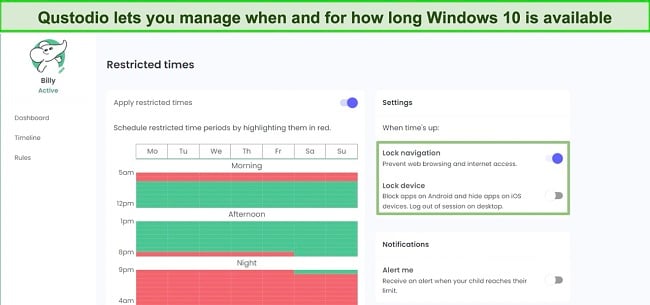
The web filter, which has 29 categories, worked seamlessly across various browsers, including Chrome, Firefox, and Edge, even during private browsing sessions. I had the flexibility to choose which categories to allow, block, or receive alerts for when my child triggered the filter.
Monitoring my child’s activity on Windows 10 was a breeze through the Qustodio dashboard. It provided a detailed breakdown of the time spent on the computer, including a chronological breakdown of every web search and the websites they visited.
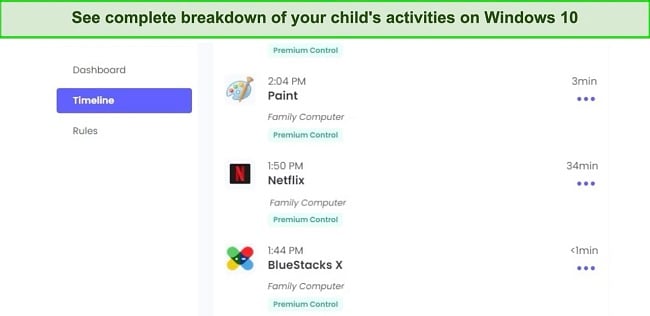
Overall, my experience with Qustodio for Windows 10 was exceptional. But you don’t have to take my word for it when you can try it yourself. Qustodio offers a 30-day free trial with no credit card required, allowing you to monitor your child’s Windows 10 computer usage and create powerful parental control rules.
2. Norton Family: Manage Screen Time Use and Set Custom Web Filter for Windows 10
- Customizable parental controls for each Windows 10 user
- Web filter with over 40 categories
- Detailed reporting updates in real time
- 30-day free trial!
Norton Family performed well during my testing process. It offers a range of features designed to promote digital safety and monitoring for children using Windows 10. With its ease of use and comprehensive functionalities, Norton Family gave me peace of mind and the ability to create a safer online environment for my children.
Norton Family is compatible with multiple Windows 10 profiles. I set up and manage the app across various profiles and adjust the restrictions I set for each of my children.
The app includes daily screen time limits and a usage calendar, allowing me to control when my child is on the computer and how long they can use it. The usage schedule has to be created using 30-minute blocks, so you can build it around your child’s daily schedule.
Norton Family goes beyond general screen time limits by offering a School Time feature. When this feature is activated, Norton Family only allows access to specific educational websites and programs, and I can also add websites to the exception list if they are not part of the default list of approved sites.
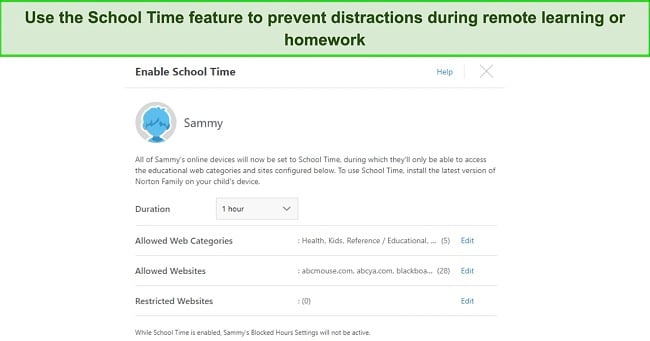
The web filter has over 40 categories, each of which can be enabled or disabled, and it worked pretty well. I challenged my kids to try and access websites that I knew should be blocked. The only time they were able to bypass the filter was by using a no-name browser. However, Norton Family has a feature that allows me to block these browsers, so my kids have to use one of the supported browsers.
The reports generated by Norton Family offer valuable insights into my child’s online activities. I can view their web activity, browser history, app usage, and time spent on the computer from anywhere by logging into the web-based dashboard.
To experience the benefits of Norton Family firsthand, the app offers a 30-day free trial, allowing parents to explore its features and functionality on Windows 10 without any financial commitment.
3. Mobicip – Web Filter with 17 Categories Prevents Inappropriate Websites From Opening
- Create Comprehensive Screen Time Schedule
- Monitor popular social media networks for risky behavior
- 7-day free trial!
One of the key features of Mobicip is the ability to schedule and limit screen time. I found it easy to set healthy time limits, allowing me to define specific time periods when my kids could use their Windows 10 devices. This feature helped establish a balanced approach to screen time management, promoting healthy habits and ensuring that device usage doesn’t interfere with other activities.
Mobicip also impressed me with its capability to monitor social media interactions. I received alerts regarding any risky interactions that occurred on popular social media platforms like Facebook and Instagram. This feature provided an additional layer of protection, allowing me to stay informed about my children’s online social interactions and address any potential concerns promptly.
The web content filtering feature of Mobicip was effective in blocking inappropriate websites and filtering out adult content. I appreciated the peace of mind knowing that my children were safe from accessing harmful or age-inappropriate content while browsing the internet on their Windows devices.
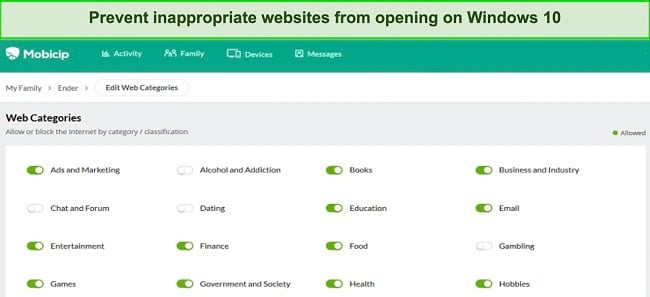
The activity summary feature provided a daily snapshot of my children’s device usage. It gave me a quick overview of the apps they used, the websites they visited, and the time they spent on their Windows devices. This helped me stay informed and involved in their online activities, enabling me to initiate discussions about responsible internet usage and address any potential issues that arose.
Mobicip offers a free 7-day trial. This trial period is a great opportunity to explore Mobicip’s capabilities and determine if it aligns with your parental control needs on Windows 10.
How I tested and Ranked the Best Parental Control Apps for Windows 10
To find the best parental control app for Windows 10, I conducted a thorough and unbiased evaluation of various apps. I purchased each app myself to eliminate any bias and objectively assessed their features, performance, and value. My goal was to find a user-friendly solution that prioritizes online safety and benefits parents seeking to protect their children’s digital experiences. Key factors considered included:
- Screen time management, which promotes a healthy balance between online and offline activities. Robust features empower parents to set limits on device usage, encouraging responsible digital habits.
- Comprehensive web filtering options were crucial for creating a safe browsing environment. Parents could block access to inappropriate content, ensuring their children only encountered age-appropriate websites and had a positive online experience.
- Activity monitoring and reporting provided valuable insights into children’s online behavior. By reviewing web history, search logs, and app usage reports, parents could better understand their children’s digital activities and offer informed guidance.
- App and game restrictions allowed parents to curate age-appropriate content. By limiting access to apps and games based on suitability, parents ensured their children engaged with content aligned with their values and appropriate for their age.
- Considering the value for price and free trials was important. Some apps offered premium features at reasonable costs, while others provided trial periods. This allowed parents to test functionality before purchasing, ensuring the chosen app met their requirements without exceeding their budget.
Based on these evaluations, I identified the most effective parental control apps for Windows 10. These solutions prioritize user-friendly features, performance, and value for money, while also offering free trials to ensure customer satisfaction.
FAQ
How do I set up parental controls on Windows 10?
Can I set up parental controls on multiple Windows 10 profiles?
Can kids bypass the parental controls rules I set up on Windows 10?
Only a Premium Parental Control App Can Properly Monitor Your Child on Windows 10
After setting up the Microsoft Family Safety parental control rules on Windows 10, I quickly realized their limitations and began exploring other options. I conducted thorough testing of premium parental control apps, and among the numerous contenders, Qustodio emerged as the clear winner, offering a comprehensive set of features and robust monitoring capabilities.
With its seamless installation process and user-friendly interface, Qustodio provided a hassle-free experience from the start. Its screen time management tools, web filtering options, and detailed reporting features surpassed my expectations, enabling me to set appropriate limits, block unwanted content, and gain valuable insights into my child’s online activities. You can try Qustodio for free for 30 days with no credit card required, so you can install it on Windows 10 and test it for yourself.

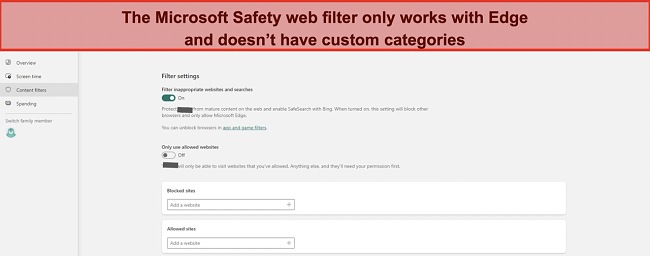
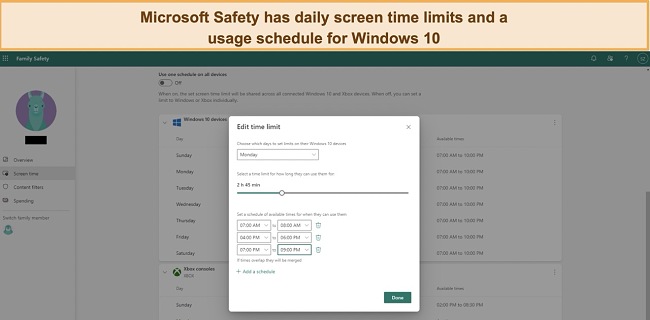

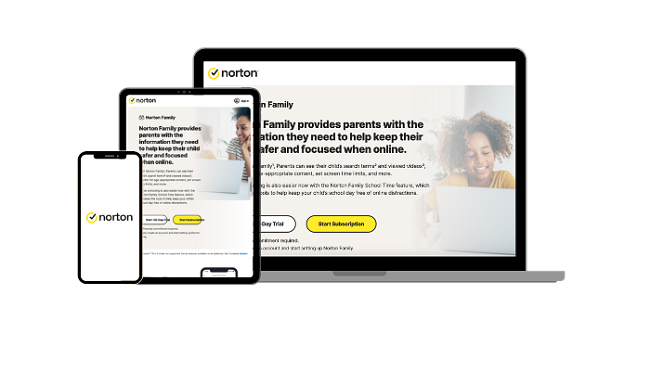
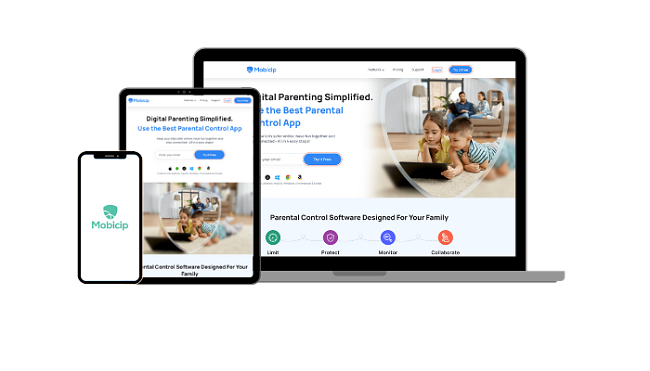




Leave a Comment
Cancel